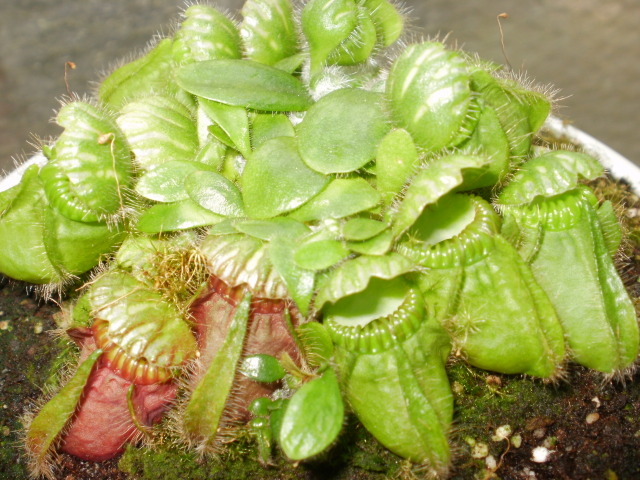Question Cephalotus typical
Cephalotus typical
QUESTION: Hi there,
I want to ask you something about my Ceph - I noticed these days the older red pitchers are becoming lighter in colour (it was only a month ago that I repotted it). Is the direct sun reason for this? Some of them close their lids and the humidity of air is high. One pitcher is becoming yellow - in the middle of the crown I can't take picture of it to see; and one non-carnivorous leaf also yellow. Everything else is normal!
Is it enough this to bother me? Is it normal old pitchers to become yellow and die? I don't keep my pots constantly in water, meaning the saucers - should I do it?
Thank you very much!
Best regards,
Dimitar
ANSWER: If the photo is of the Cephalotus you are describing, it looks fine to me.
Older leaves naturally die, as all leaves have a natural lifespan, and after transplanting a plant will often lose a few of the older leaves because the roots are not as effective at keeping all parts of the plant moist until the roots become comfortable and efficient in the new growing medium. If the lids of the traps are closing even though the humidity is high, it may be another indication of this same effect and the temporary lack of efficiency of the Cephalotus's roots.
Cephalotus can tolerate full sun if the air is cool, but when the air is hot, they often grow better in slightly shadier conditions.
Cephalotus roots are very fleshy and susceptible to rot, so it's good to ensure that there is plenty of air in the growing medium and that it is not soggy or saturated with water. For this reason, I personally don't keep most carnivorous plants sitting constantly in water, and for Cephalotus, it's sometimes wise to make the growing medium a little more loose and airy than for other plants.
For answers and comments from other growers, please register at an online carnivorous plant forum such as the following--
FlytrapCare.com Forum
http://flytrapcare.com/phpBB3/
CPUK Forum
http://cpukforum.com/
Best wishes,
Steve
---------- FOLLOW-UP ----------
QUESTION: Hi Steve,
Thanks for the reply.
Yap, this is the current photo of the plant.
If I understood right it is normal for pitchers to die and non carnivorus leaves. I grow them with success in a terrarium with lowland conditions; humidity is 80% during the day and 90/100% at night. Is this OK?
When I repotted it one month ago I cut the older plastic pot with a sharp knife. I took the whole plant with the soil out without disturbing the roots. The plant was upright and the fluid in the pitchers is still there. But I didn't know what was his previous substrate - maybe it was only peat moss. Now I put it in a new media (peat and perlite 1:1)as it was with the old soil. Is this the cause it to lose pitchers?
Thank you.
Best regards,
Dimitar
AnswerI personally avoid growing anything in a terrarium, which introduces too many problems and potential problems in my opinion. Cephalotus do not need such high humidity, although it is characteristic of their native environment. They like plenty of sunlight if the air is reasonably cool, but direct sunlight often cannot be given to plants in a terrarium without risk of overheating both the air around the plants and more unfortunately, the growing medium and root zone. Terrariums concentrate disease organisms (fungal and bacterial) and when undrained can build up toxic levels of dissolved mineral salts and other soluble material, as well as promote anaerobic conditions (water saturated conditions) in the growing medium that can promote disease.
Although you repotted carefully, you may have broken some of the Cephalotus's weak and brittle roots. At the least you disturbed them, and it may take some time for them to recover and be as efficient as before.
Because I don't grow in terrariums, you will probably receive better answers by posting them at one of the online forums mentioned in my previous reply.
Good luck and best wishes,
Steve






